This week, the latest breakthroughs in cancer including blood tests to pick up the disease much earlier, new genetic treatments to trigger tumours to kill themselves, and a laser technique to zap cancers in hard-to-reach places. Plus, in the news, why working the night shift can curb your intellect, a super-enzyme that could cut millions off energy bills and the gut bacteria that keep you trim...
In this episode

00:53 - Does shift work affect your brain power?
Does shift work affect your brain power?
with Hannah Critchlow, The Naked Scientists
If you were listening to us at the end of a nightshift or on your way into work after getting up before dawn, our first item may not come as a surprise. Researchers say that doing anti-social shifts over many years can actually dent your brain power.
getting up before dawn, our first item may not come as a surprise. Researchers say that doing anti-social shifts over many years can actually dent your brain power.
But why is this? And if you stop working irregular hours or nightshifts, can your cognition recover. Hannah Critchlow has been taking a look at the study for us and joined Naked Scientist Ginny Smith to discuss the results...
Hannah - Well, it's long been known that if you have altered sleep patterns, or you don't have enough sleep, then it will affect, most probably, your metabolic or your cardiovascular. So, it could give health problems for example with your heart or with ulcers for example. It can also affect your mood and it can have short term effects on your memory or your cognitive functions.
But what hasn't been known before is whether changes in sleep patterns and doing rotational shift work would have a long term effect - so, 10 years down the line.
So, this study has been our first in its kind. It's looked at over 3,000 people and it's followed them over a 10-year period and then found out that firstly, yes, shift work can actually affect cognition and it had a detrimental effect on memory and speed of processing in these different tasks. But then they also found out that if you stop to doing shift work, then within 5 years, you would actually reverse that cognitive decline and go back to normal, as it were.
Ginny - How much shift work do you have to do before you see these effects? Is it just a case of a night of not getting enough sleep and you have memory problems or is it something more complicated?
Hannah - If you don't sleep well for one night then yes, your memory might be slightly skewed the next day. But they were showing that it's kind of over a 2-year period that you start seeing a really significant or slightly significant effect on cognition. If you work on shift work for 10 years, then you'll show a really significant decline in your cognitive function, to a point where your behaviour, your cognitive age is similar to someone who's 6 years older than you.
Ginny - Wow! That sounds like a huge effect. If it's not just the case that you haven't got enough sleep, if it's something that carries on for longer than that, do they know anything about what the mechanism is that causes these problems?
Hannah - Well, they hypothesise that it might be because your sleep patterns are altered, your cortisol levels are also altered. So, cortisol is kind of the stress chemical of the brain if you like, and it helps in some ways. It helps us to wake up in the morning. If you've got altered sleep patterns - you're sleeping at different times and waking up at different times - then obviously, your cortisol levels would be changed. Cortisol we know, affects kind of the key region in the brain that's involved in learning and memory. It's an area the hippocampus. This area of the brain is also very important because it's one of the few areas of the brain where you get new nerve cells being born throughout life. This might be important for learning and memory.
So, it may be that this kind of chronic shift work is affecting the new nerve cells being born via the cortisol levels. The authors of the study are propositioning that possibly, if you are unable to stop shift work then it might be a good idea to do other things that might help boost the birth of new brain cells in the hippocampus. So for example, exercise and socially interacting with other people, that can help boost new nerve cells and also, exercise decreases cortisol level, so that could be good.
Ginny - And they looked at people after they quit shift work as well and found that this problem went away. So, how long did it take and what happened with those people?
Hannah - So, if people had stopped doing shift work and they're now working in a more standard 9:00 to 5:00, then within 5 years, their cognitive profile would be similar to age and socio-economic matched controls.
Ginny - So, if you are a shift worker, it's not the end of the world. Your brain will get better as you give it up and even if you can't give it up, there are things you can do to improve your learning memory and your general cognition.
Hannah - Exactly.

04:53 - Cutting the cost of electricity
Cutting the cost of electricity
with Mark Peplow, Science writer
 A large coal-fired power station can pump out up to one hundred thousand of tonnes of carbon dioxide per day, making it hard for countries like the UK to meet their obligations to cut greenhouse gas emissions.
A large coal-fired power station can pump out up to one hundred thousand of tonnes of carbon dioxide per day, making it hard for countries like the UK to meet their obligations to cut greenhouse gas emissions.
There are ways to remove or scrub CO2 from what goes up the chimney, but they're very expensive to operate.
Now a research team in America have come up with a way to make this scrubbing process much more economical. They've found a bacterium that makes an enzyme, which is a kind of biological catalyst, that can turn carbon dioxide into a soluble chemical called bicarbonate.
By introducing random changes - or mutations - into the genetic instructions that tell the bacteria how to make the enzyme, they've been able to come up with a new super-powerful version of it, that might save us millions on our power bills.
Science writer Mark Peplow spoke with Naked Scientist Chris Smith about what this enzyme can do...
Mark - It's called carbonic anhydrase. This is an enzyme that's normally found in your body where it helps to transport carbon dioxide out of your tissue. It does this by combining carbon dioxide with water to make soluble bicarbonates and a hydrogen ion. Now enzymes are proteins and they'd normally be destroyed at the high temperatures and the harsh conditions that are normally used in carbon capture systems. Just think about what happens when you put an egg in a frying pan. The albumin in the egg white gets completely broken down and it goes solid and white and rubbery.
Chris - So, when you would be applying this technology, you're saying that this enzyme would have to tolerate the flue gases coming out of a power station or something. So, this can be really high temperatures.
Mark - Well, that's right. So, what happens normally when people are trying to set carbon capture systems on a fossil fuel power plant, it uses special solvents called amines. They grab hold of carbon dioxide molecules before they fly up the chimney. You then pipe the solvent away, carrying the carbon dioxide and you heat it up to release the carbon dioxide into a storage container so that it doesn't escape. The solvent then gets cooled down and cycled around to do the same job again. The trouble is that all this heating and cooling, and the equipment that you need to do it is really expensive and it potentially adds hundreds of millions of pounds to the cost of a powerplant which makes the electricity more expensive and it reduces the plant's power output as well. That's been a huge barrier to widespread use of this system. This is where the carbonic anhydrase comes in because it can help to capture the carbon dioxide and make this process much more efficient. The trouble is that in the past, enzymes, because of their sensitivity, couldn't stand up to the hundred degree conditions and harsh alkaline conditions, of this heating and cooling of the amine solvent.
Chris - So, where did these American researchers come by this super enzyme? How did they make it?
Mark - Well, they got have a bacterium and then they introduced random mutations into the enzyme to see if they could make it tougher in a process that's called directed evolution. So, you get lots of the random mutations and...
Chris - These are genetic changes aren't they? You're adapting the DNA of the organism just by making mistakes if you like, spelling mistakes in the DNA.
Mark - Yeah, you make deliberate spelling mistakes in the DNA and lots of different types of mistakes. That gives you a whole pot of new mutated enzymes. Most of them are rubbish but a few will be a bit tougher. They did nine rounds of this directed evolution and each round, they picked the toughest enzyme that they got at each stage and then they made more mutations to that particular enzyme. In all, it meant that they tested more than 27,000 different mutated enzymes. At the end of that process, they end up with one which is the superman of all of these enzymes and it can withstand more than 100 degrees of temperature and a pH greater than 10, so that's almost as alkali as household bleach.
Chris - That's almost the enzyme equivalent of the indestructible or invincible man, isn't it? I mean, really, really tough. So, have they actually got evidence that this can work?
Mark - Well, this is the exciting thing about this paper which came out this week in the proceedings of the National Academy of Sciences. They haven't just done this in the lab. They tested this enzyme in a pilot carbon capture unit attached to a coal-fired plant. They found that it improved the carbon dioxide absorption of the amine solvent system by 25 times. It allowed it to remove about 60% to 70% of all the carbon dioxide from the plant's waste stream and they ran it for about 6 days with no loss in performance at all. So clearly, the enzyme is working and it's really robust. This faster absorption that it can allow you to do means that you could have much smaller processing units running at lower temperatures. And that could potentially make carbon capture a lot cheaper. They've done a cost estimate in fact and they think that if you scale this up, it could knock more than $100 million off the cost of a full scale unit. That might sound like a huge figure and they're extrapolating quite a lot. But it's important to say that the researchers that had been doing this, they're pretty big hitters. They're involved big Industrial enzyme developers like Codexis and Novozymes, and they partnered with BP Biofuels on this. They've been backed by research funding from the US Department of Energy. All of that I think makes it quite promising that this is going to go forward for further development.
Science writer Mark Peplow.
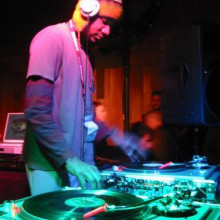
10:33 - Sonic Pi: coding tunes in the classroom
Sonic Pi: coding tunes in the classroom
with Dr Sam Aaron, Cambridge University, Swoomptheeng musician Skull Eyes, Dr Pamela Burnard, University of Cambridge
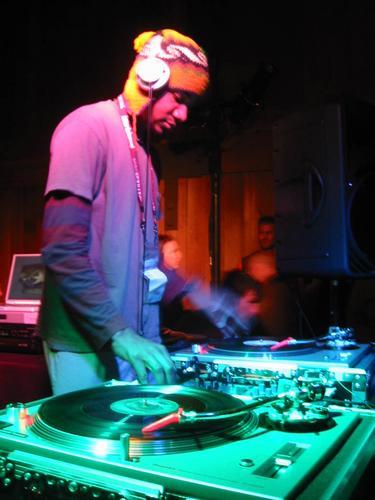 A new study from the University of Cambridge has found that making music in classrooms using computer coding could revolutionise the teaching of both subjects. Teenagers have been trying out a system called Sonic Pi. This uses the SAME coding techniques to create tunes that professional computer programmers use to make websites.
A new study from the University of Cambridge has found that making music in classrooms using computer coding could revolutionise the teaching of both subjects. Teenagers have been trying out a system called Sonic Pi. This uses the SAME coding techniques to create tunes that professional computer programmers use to make websites.
Graihagh Jackson went to the Sonic Pi Summit - a meeting of teachers, music makers and programmers - to meet Sonic Pi inventor Sam Aaron...
Sam - One of the things that we're learning as society is the importance of programming for creating new ways of interacting with the world around us. And that can help support the current activities to make them more efficient, but it can also give us new possibilities and new ways to express ourselves.
Graihagh - Tell me what you initially set out to do.
Sam - So, I built Sonic Pi to make it easier to get a creative engagement with programming. I build a very simple system which allowed you to make simple beeps and to time the beeps and the changing sound of the beeps. But through that, we're able to teach fundamentals of programming. So, we're able to teach iteration - so, it's doing things a number of times like 5 times or you can teach basic conditional - so, if this is the case then do that. Otherwise, do something else. Now, all these things are really valuable for creating music but also, they're all fundamental computing constructs. So, we're actually sneaking in some computing while also learning how to do music.
Graihagh - I was going to say, is there something that you actually use in coding rather than just it being a nice fancy gimmick to involve creativity in coding?
Sam - Absolutely. I mean, the fancy gimmick is just a way of sneaking in the programming. What they're actually using is a professional programming language to do all the stuff in. And so, the skills they're learning to make the music are skills which are absolutely applicable in the industry, which is quite exciting.
Graihagh - Can we have a play?
Sam - Absolutely. So here, I've got a very basic - what I call a live loop. In that loop, we're just playing the note 50 and skipping for a second. So, if I started off...(sound) you should hear it. It's just beeping like that now. What we'd like it to do, is it too low, is it the wrong kind of sound, is it going too slowly?
Graihagh - A little bit slowly I think for my taste.
Sam - You want to make it go a bit faster? So, to make it go faster, well, if we're sleeping for one second between each note, so, shall we down to half?
Graihagh - Why not?
Sam - So, if we put in half there and I re-evaluate the code, you could hear it now going faster. Another thing we could do is that note might be a bit too long. So, we could reduce the length of the note. So, we can use what's called an envelope to reduce the amount of time that that note lasts for. So, if I put, release 0.1 second, we hear it's going very short. This is a very bassy note so maybe we want to take it up a couple of octaves. It's quite nice, but maybe you want to add some reverb and have echo going. I can change the phase duration of the echo and then that's the same note every time. So, maybe we want to choose random notes. So, we choose note from chords E3 or E2 minor. It's a bit too low as an octave so maybe we go up to...(sound) make it go faster...get rid of the echo. And then we can start playing our different synthesizers. So, that's a basic beep sound. How about a soul wave... or a profit wave? (sound) That sounds nice in different cut-offs...(sound)
Graihagh - So I should add, you are literally just typing very simple...
Sam - How many lines? This is 9 lines.
Graihagh - Nine lines but not very much at all and it's very much what I imagined, as a non-computing coding person, what it would look like on a backend of a website or an app.
Sam - Exactly, how it is. It's the same kind of code. Ruby's actually used often has been used quite a lot recently to make websites with. It's the same language you might write your business logic in. Here, I'm using to write and configure synthesizers and effects.
Graihagh - What struck me was that it was a lovely fusion of disciplines, something that is often missing from the classroom when the days are divided by the hour with maths in first period, art in second. What I was keen to know though was, could you actually create a half decent song using Sonic Pi.
Skuulleyes - Hello. I am Skulleyes from Swoomptheeng and we are one of the artists who is invited to create music video for the Sonic Pi project.
Graihagh - What's the track that you're playing here today?
Skuulleyes - The track is called In Thread. (music)...
Graihagh - So, you can create music but can you learn to code with Sonic Pi? Is it more than just a gimmick? Could children go on to build their own websites or apps, having played around with Sam's creation? Pam Burnard from the Faculty of Education at Cambridge, whose research from Sonic Pi was released just this week.
Pam - We found that young people learn differently. They work differently, they think differently, and engage differently when they're coding. I've taught in classrooms in secondary schools, in primary schools for 15 years and I've not seen the nature of this engagement. It's an engagement with a technology that is not about playing the outside of something, but actually, programming from the inside.
Graihagh - But is this just more than a bit of fun? What are students actually coming away with?
Pam - I think this is sort of the whole contemporary aspect of being able to code and control as a young digital learner, this is very comfortable for them, though there are risks. The risk being that their code crashes.
Graihagh - What do we mean by risk and is that necessarily a good thing?
Pam - The risk taking actually launched them into a different space, a learning space where to take risks meant that they're actually being created. They were problem solving out of crashes with codes. These code crashes like sort of car crash. It's pretty exciting and then to kind of solve the problem and to be able to perform on is one of the big things it was doing. That's why one of findings is that it engages in diverse and new learning pathways.

17:26 - Bats jamming to get their dinner
Bats jamming to get their dinner
with Jade Lauren Cawthray, Ecologist
When bats swoop in darkness to catch their dinner, they emit high-pitched sound waves and then listen to the echoes that come back. They use this echolocation technique to find food AND also to avoid crashing into things. Now scientists have discovered that they also use the sounds for more nefarious purposes: they can JAM the echolocation of other bats. Jade Lauren Cawthray works with the Wildlife Trust; she's also a bat enthusiast and takes groups on night-time bat walks. She's been taking a look at this new study and Ginny Smith spoke to her to find out more...
Ginny - Jade, can you tell us a little bit about how echolocation works to start with?
Jade - Yeah. So, with echolocation, a bat literally does this very, very big shout and the soundwaves travel through the air and then bounce off the environment and they come back to the bat, giving an idea of the shape and the textures of its environment. So, objects that are really close to the bat, the sound will come back to the bat nice and quickly. So, it knows it's not very far away, say, a moth for example. But if there was a tree much further away, the soundwave would take a longer amount of time to come back to the bat so it knows it's much farther. So, they get an idea of distance and the shape of their environment.
Ginny - So, you say the bats are shouting, but when I go out at night, I can't hear a load of noise coming from the sky. Why is that?
Jade - So, bats do shout and they shout very, very loud. They shout at about 110 decibels which is equivalent to a jet flying low overhead. So, it's a really, really loud noise. But the shout is actually a different frequency. A frequency above that which we as humans can hear. So, we can hear up to about 20 kilohertz but the bats, their echolocation can be anything from 20 to 200 kilohertz. So, it's just a frequency above what we can hear.
Ginny - So, it's just too high pitched for our ears.
Jade - Yes.
Ginny - But you've got an example of some bat noise that we can actually hear that I think you've brought with us.
Jade - Yeah.
Ginny - Do you want to play that for us?
Jade - (bat noise). So here, what you can hear is a slowed down version of bat echolocation and you'll hear these little shout points and they're getting faster and faster. And they get faster and faster as the bat gets closer to an insect. So, as it gets closer and the insect is moving around, it needs to be able to pinpoint where the insect is more accurately. So, it does more and more shouts to get more and more information of the location of the insect.
Ginny - But now, some researchers have found out that bats are doing something completely different with their echolocation.
Jade - Yeah. So, this piece of research that has been released this week, it's quite exciting because it's the first time something like this has been recorded. Basically, what they found is in Mexican free-tailed bats, the bats are actually interfering with each other's echolocation. So, one bat will make an echolocation call, trying to capture an insect, but another bat will come along and send a different type of sound, a different type of call that actually interferes with the soundwaves of the first bat. What this means is that the first bat isn't able to judge the distance of the insect as accurately and actually misses the prey.
Ginny - I think we've got a recording of that one as well.
Jade - (bat noise). So, you can hear that like we had before and then in a second, you can hear like a whistly up and down noise. This is a kind of jamming tone that they're doing. They're making this very different call around about the time that the first bat is increasing the speed of its echolocation. So, as it's starting to hone in on that insect, the other bat starts to send a different frequency which stops it capturing the insect.
Ginny - It sounds quite different so it's not just that that bat is also echolocating to find that insect. Are they really trying to prevent their fellow bats from getting food? I thought bats are quite a social species.
Jade - Yeah, so the report suggests, they look very carefully at this. They wanted to know, was it that the second bat was trying to disturb the first bat by sending the sound towards the bat or were they trying to capture the insect and sending the noise at the insect. And they seem to be sending it at the insect to interfere with those soundwaves. So, they're definitely trying to prevent the other bat from getting the food. The Mexican free-tailed bats are quite famous particularly in the States because they roost in numbers of a million or more individuals. And so, what could be happening here is that because there are so many individuals, the number of insects available per individual is much lower. So, there's actually more competition between them for food.

21:57 - Peeking at poo: how some stay slim
Peeking at poo: how some stay slim
with Dr Ruth Ley, Cornell University
 A study comparing the bugs living in the guts of identical and non-identical twins has helped scientists flush out a strain of bowel bacteria that are controlled by the genes that you carry and which appear to help some people stay slim.
A study comparing the bugs living in the guts of identical and non-identical twins has helped scientists flush out a strain of bowel bacteria that are controlled by the genes that you carry and which appear to help some people stay slim.
Naked Scientist Chris Smith spoke with Ruth Ley who made the discovery at Cornell University in the States with help from a British bunch of twins...
Ruth - We're very interested in the kinds of microbes that live in people's guts and we know that there's hundreds of thousands of different kinds living there. And we know that everybody has got their own special mix. And up until now, the thought has been, it's what you eat or your lifestyle or who you hang around with, that really is the key to your personal mix. But what we wanted to know was, what if it's your own genetic makeup? Does that have any effect?
Chris - How can you disentangle though the fact that all of us are different? And we all have different lifestyles, we all have different parents, we all have different preferences for food, drink, and so on. How did you get that away, that lifestyle effect away from the genetic effect then?
Ruth - You can use twins. There's two kinds of twins. There's identical twins and the identical twins have exactly the same genetic makeup. They're essentially clones of each other. And then the other kind of twin, fraternal twins. And so, fraternal twins are basically siblings that are born at the same time. because the twins are all born together, they'll be exposed with the same things, they'll grow up in the same house. And so, those environmental influences are going to be the same. And so, if you find that something is more similar for the identical twins, you know that it's not just a shared environment that's done that.
Chris - Indeed. So, what did you find then when you did this?
Ruth - So, what we had to do is ask these twins. I know hundreds of them, to send us some of their poo.
Chris - Was that in the form of soiled nappies or just samples in parts? How did this come to you?
Ruth - Well, these are all English people actually. These English twins, I used to working with the UK Twin Registry in London. So, they're coming once a year for an annual visit. This time, they brought with them some poo. The poo is about half bacterial cells. Each one of those cells has got DNA in it. We can tell what kinds of bacteria there by sequencing a particular gene that tells us what kind of bacteria that came from. And then what we can do is tally them all up. We do that for all the twins and then we see if the identical twins have more similar profiles than the fraternal twins.
Chris - Well, do they?
Ruth - Well, they do overall and then we found that there's particular kinds of bacteria for which that's particularly true. So, there's particular kinds of bacteria that are very much influenced by the host genetic material whereas others are not at all.
Chris - What fraction of the bugs as a whole were determined by the genes of the person carrying them?
Ruth - It's a small fraction but we think it's a very important fraction because what we noticed is that they tend to be more abundant in thin people compared to obese people. We did some experiments with very special mice that are born and bred in bubbles. They don't have any bacteria or any microbes in or on them.
So, what we did was give them poo from an obese person that didn't have these special bacteria that we're interested in and then we took another set of mice and gave them the same poo, but this time, we did add our special bacteria that we're interested in. What we noticed after 3 weeks is that the mice that got the poo plus this special bacterium was thinner than the mice that got poo from the obese people without the special bacteria. And so, what that told us was that these special bacteria are able to make the mice thinner than if they're not there.
Chris - Did you compare how much the fat and thin mice ate? In other words, could you actually say, "Well, these mice are slimmer despite eating the same amount" or were they just eating less because they didn't feel so good?
Ruth - No, they did eat the same. So, when we see these bacteria more abundant in thin people, we think maybe people are thinner in part because they've got these special bacteria helping them maintain that healthy weight.
Chris - Would your interpretation be then that you have a certain genetic makeup, your genetic makeup determines or influences what sorts of microorganisms you carry in your intestines and that in turn influences how you tend to handle energy - food that comes into your body - whether you turned it into fat in other words?
Ruth - We do think that something exactly like that is happening. That the genes are influencing the types of microbes that we have and the microbes are then influencing our body type. Now, whether that is actually through how we handle food or some other way, that is something that we're still trying to understand now.
Chris - There's a lot of emphasis being placed on the phenomenon of 'transpoosion' now, isn't there where people actually give poo transplants from one person to another to help them to recover from various intestinal diseases. Do you think then that one approach might be to get together with a few thin people if you're trying to shed a few pounds and ask them for a 'transpoosion'?
Ruth - I don't think that's necessarily a very good idea, but I think that eventually, we might want to have this particular bug that I'm talking about, these special bacteria and just take those directly in a capsule.
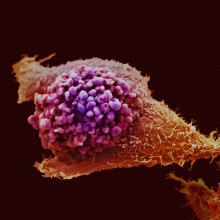
27:48 - Quick fire facts on cancer
Quick fire facts on cancer
with Tim Revell, Georgia Mills, Cambridge University
Naked Scientists Tim Revel and Georgia Mills have some quick fire facts and misconceptions 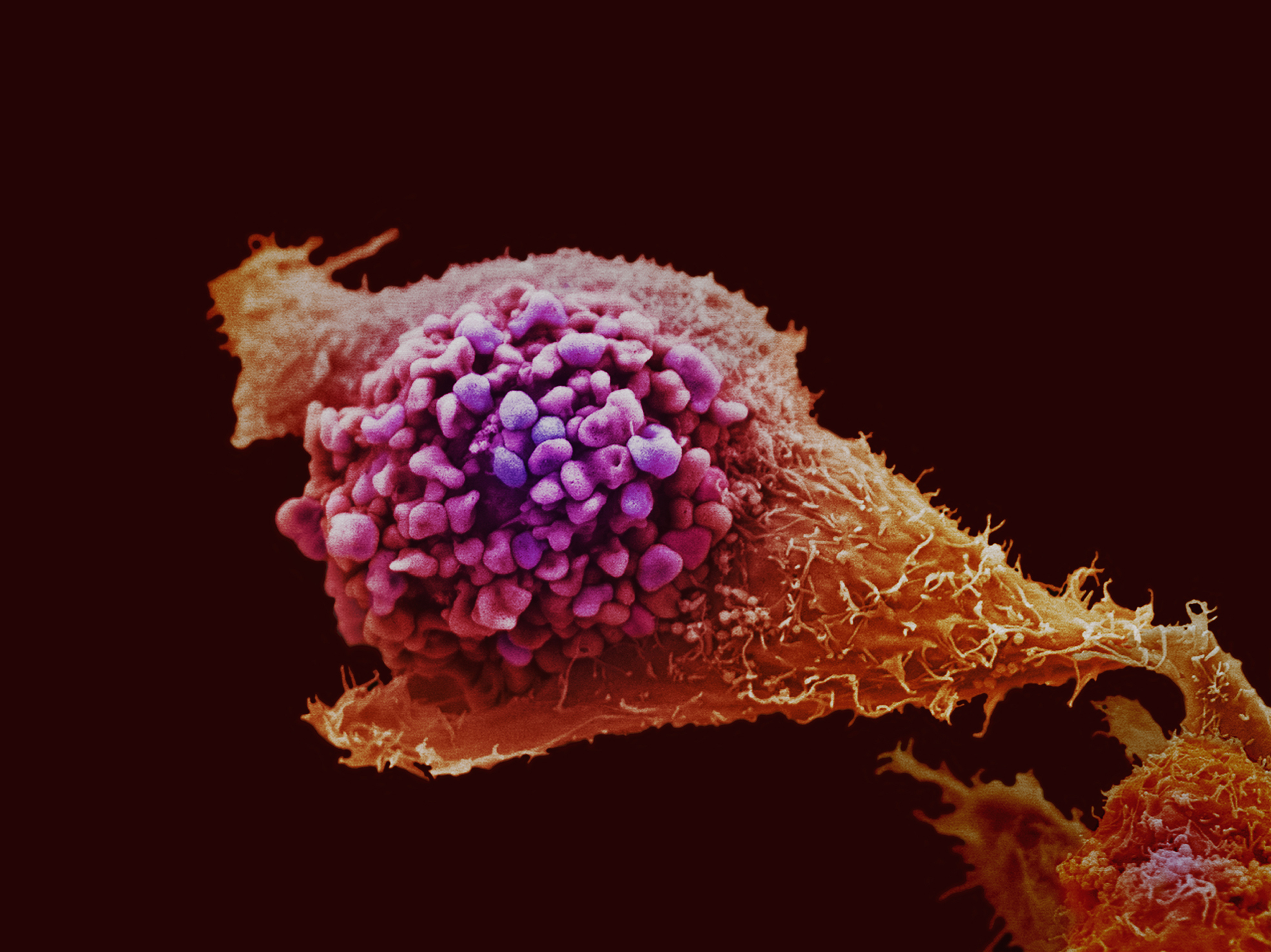 about cancer...
about cancer...
Tim - There are over 200 different types of cancer. But genetic research suggests that every cancer may be unique to the individual.
Georgia - Cancer causes your cells to divide abnormally which then starts spreading around the body.
Tim - Abnormal cell division leads to the extra cells building up in a clump, which is called a tumour.
Georgia - But not all cancers make tumours - for example, leukaemia.
Tim - There are over 14 million cancer cases worldwide each year, causing around 8 million deaths.
Tim - Often, the cancerous cells prevent healthy cells from doing their job correctly.
Georgia - Radiotherapy, chemotherapy and surgery are three of the most common cancer treatments.
Tim - And they are often used in combination.
Georgia - Surgery has the best overall success rate.
Tim - This method aims to directly cut out cancerous cells from the body.
Georgia - While radiotherapy involves precisely firing high energy rays at cancer cells and eventually causing them to die
Tim - And chemotherapy uses drugs instead of radiation to achieve the same effect.
Georgia - Now, for some myth busting: fact or fiction...
Tim - Cancer is a recent man-made disease.
Georgia - Fiction.
Tim - Cancer was described by the ancient Egyptians and the ancient Greeks
Georgia - And has been detected in mummies, early skeletons and even in dinosaurs.
Tim - Cancer is on the rise, but that's mostly because we are living longer.
Georgia - As well as smoking, drinking and eating too much.
Tim - Super foods prevent cancer.
Georgia - Fiction.
Tim - There is no such thing as a super food. It's a marketing term, not a scientific one.
Georgia - A diet rich in all kinds of fruit and veg will help to reduce your cancer risk. But eating a few trendy berries on top of an unhealthy diet isn't going to be much help.
Tim - Cancer treatment kills more than it cures.
Georgia - Fiction.
Tim - Now, it is true that a lot of people die after cancer treatment.
Georgia - But this is usually because the treatment just didn't work or came too late and people succumb to the disease.
Tim - Cancer treatments are not without their risks, but new treatments and earlier diagnoses have increased the number of survivors.
Georgia - Many cancers still have poor outlooks, but there are some success stories.
Tim - 96% of men diagnosed with testicular cancer are now cured...
Georgia - ...compared with only 70% in the 1970s.
Tim - Three quarters of children with cancer are now cured...
Georgia - ...while only a third were in the '70s.
Tim - It's still a big problem, but we know more about cancer now than ever before.
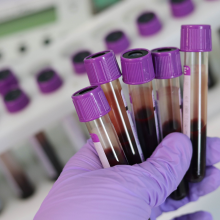
30:36 - Can a blood test diagnose cancer?
Can a blood test diagnose cancer?
with Dr Ian Cree, Warwick University
Naked Scientist Kat Arney, also works as a representative of the charity Cancer  Research UK.
Research UK.
She has been at the National Cancer Research Institute's annual conference, which just took place in Liverpool. There she spoke with Warwick University scientist Ian Cree, who's working on a way to hunt for cancer using a blood sample...
Ian - What we're hoping is that we can develop a blood test for cancer.
Kat - This seems to be the dream, isn't it? We see these stories popping up every so often, blood tests could detect all kinds of cancer. How does yours work and is it, the key thing, reliable?
Ian - Well at the moment, we don't know. What we've done is to trawl the literature and we've actually discovered 816 markers for cancer that could be used in this way.
Kat - So, what do we mean by markers?
Ian - So, markers are things that circulate in the blood. Cancers have various attributes and each of those attributes produces things, changes in the blood which we can measure and we call those biomarkers.
Kat - Now with your test, if you could pick up different types of cancer, how would you know what cancer it was, where was it in the body because I guess this is a problem? You can't just go, "I think you've got cancer, but we don't know where it is."
Ian - Well, we actually think that's one of the problems with the previous work in this area that everyone has been looking for specific markers for specific cancers. We actually think that a generic marker will work better and that we'll need to use multiple markers and the negatives to help the positives, that sort of thing. So that we're able to detect the cancers as early as possible. It doesn't actually matter terribly much if we don't know exactly where they are because radiology is now good enough that we can detect some very small changes. We know where most of the changes are going to be by taking the generic test and then triaging the patients to reflex what we call 'reflex tests'. Those reflex tests will allow us to determine a bit more about the cancer site and if there actually is one there. So, we'll increase the specificity and we'll increase the knowledge of where it might be.
Kat - So, you'd give someone this test and say, "We think you should go on for a CT scan or further investigations."
Ian - Exactly, yes. That's right. we'd look to see whether there was anything other that they could do that would help to determine whether they actually had a problem. The whole point of this is to detect the cancers really early so that patients can be treated and probably walk out the door ideally the same day without ever having known they've had one.
Kat - It sounds wonderful that you could have a blood test that would pick up all sorts of different types of cancer, but how soon do you think this would be actually available say, in the clinic?
Ian - Well, I'm afraid like most of these things, it's going to take some time. at the moment, what we've done is to look through literature. We've collected a very expert group of people together, so we've got a fabulous team which is very experienced in looking at all the different biomarkers that we're interested in, and in the ancillary things that we need to do. So, there a big statistical questions to do around this. There's a lot of other work that we need to do before we can put it into the clinic. We're hoping to start testing this next year and as a concept, and then develop something which would be then submitted to a clinical trial probably, in about 3 or 4 years time.

33:55 - New treatments for cancer
New treatments for cancer
with Dr Neill Martin, Chief Operating Officer and Co-Founder of Mission Therapeutics
New chemical treatments that selectively target cancer cells and leave the healthy  ones intact.
ones intact.
Chris Smith spoke with Dr Neill Martin, Chief Operating Officer and Co-Founder of Mission Therapeutics. They're trying to trigger what they call "synthetic lethality" in cancer cells by deactivating certain critical systems that cancer cells rely on to grow and remain alive. Healthy tissues have backup systems, but cancers don't, so switching off these systems makes the cells self-destruct.
Chris - Tell us first of all, what's going on in a cancer cell genetically. Why does it have this Achilles' heel that you're plugging into?
Neill - So, a cancer really likes to be genetically unstable. It likes to be very mutational. So, what it does is it tries to switch off a number of these genes which protect a normal cell. By switching those genes off, it actually becomes mutational and therefore, it creates the sort of environment that cancer likes to grow in and force the sort of growth of that cell.
Chris - So, what you're saying is that in order to be a nasty cancer, it's a sort of a self-fulfilling prophecy. If it turns off a lot of these genes that normally keep cells in check, it makes itself able to gain lots of other properties of a cancer, but at the same time, the downside is that it's more vulnerable.
Neill - That's right, exactly that. So for us at Mission, what we do is we study the DNA repair processes and within the DNA repair processes, a normal cell has about 5 or 6 of those. A cancer cell will try and switch some of those off because it wants to actually increase its mutational rate. DNA repair protects the DNA. So, when it does this, it then actually creates that sort of environment.
Chris - Isn't that roughly how current therapies against cancer work? They're exploiting the fact that cancer cells are actually quite weak and they're very easy to damage. And so, when we give these drugs or radio therapies and things, you're actually making more damage to the DNA which in turn makes the cell fall apart.
Neill - That's it, correct. But the big problem with that is it also damages the DNA of a normal cell and that's where you get the problems and that's why a lot of patients suffer from this sort of chemotherapies that are given. What we're now trying to do is actually, use that Achilles' heel, understand it a bit more, and actually tailor the treatment to that cancer cell and rather than the normal cells and therefore, protect the normal cells but kill that cancer cell.
Chris - You're going in and finding which of these systems have been disconnected in the cancer so that you can hit the one that it is the thread it's dangling by genetically. But isn't by definition cancer a sort of mixed population? If we go and look at a cancer, we'll see, because of all these mutations and genetic changes, we're going to see lots of cells that are screwed up in lots of different ways. So, is there just one Achilles' heel?
Neill - What we're finding I think is that for a number of cancers that there's a very early switch and therefore, that you do get heterogeneity in cancers and different types of genetics that are evolved from that, but there'll be a very early switch. We're starting to see that for example, the DNA repair processes are one of those early switches that change the environment. Therefore, all the tumour cells that then evolve from that tend to have that same genetic background.
Chris - So, they're still inheriting that nonetheless. So, if you go in on that, that is the one thing that is consistent and constant throughout all of the tumours.
Neill - Yes, exactly.
Chris - What would you do then? Do you go and say, "Well let's have a sample of someone's tumour and let's unpick it genetically and see what these areas are that it's deactivated" or what it's still using, so you know how to go in?
Neill - Yes, exactly. So, the way that we will be evolving this is by creating the sort of genetic test to go with the therapy so that you can actually then diagnose or take a biopsy or as Ian was saying, some sort of biomarker even from the blood, get to understand what that tumour type is. And then because we actually know that it might have this genetic defect, actually tailor the treatment to that cancer. That's really the personalised healthcare that we're looking for now within the sort of cancer field.
Chris - Well, let's look at how you do that then. So, you look at a tumour, you find what its genetic mechanisms are and you say, "Right, we're going to target this particular mechanism." How do you then go about that, making a treatment for a person to do that?
Neill - Well, because we know that, what we can do is we can actually take that right back to the fundamentals, so almost back to the Petri dish within the lab. So, we then can actually start to look at, "Okay, this is what's actually been switched off." We can then look to see what's actually remaining within that cancer cell and then look for the drugs that switch those mechanisms that are remaining within the cancer cell.
Chris - But do those drugs exist? Are there chemicals already that you could put your cancer in a dish and ask, "I want to turn off that particular gene and there's a drug that'll do that"?
Neill - We're actually starting to see within the sort of clinical trials, a number of those drugs which are actually personalised and actually targeting certain tumours and different tumours in a non-cytotoxic way.
Chris - In other words, not killing other cells in the body. So, they should be very, very discrete. It should just go through the tumour because your other cells in the body have all their other systems intact even if you disable temporarily with your drug, one of them, the other 5 strands are going to keep it together.
Neill - Exactly, that.
Chris - Where are you in terms of the progression towards a market with this? Are you at a clinical trial stage yet?
Neill - We are. Previously, we've created a number of products which are now in clinical trial. At Mission, we're still quite - our labour is still in the pre-clinical. What they call a pre-clinical, the sort of testing phase. And we're probably about 4 or 5 years away from clinic in terms of being able to try these products out.
Chris - What sorts of diseases are you going for?
Neill - Well there are a number of diseases, but we don't know now, that diseases such as what's known as BRCA of which there was a high profile case of Angelina Jolie recently. Those diseases really are genetic diseases, and if you can get the right treatments, for those types of diseases you can actually selectively kill the cells.
Chris - She underwent a double mastectomy, didn't she, as a preventative measure. She didn't have breast cancer but she does have that gene which we know is linked strongly to premature development of breast cancer at a very young age. . are you saying that had she pursued your approach, given the option of course, I mean it wasn't a choice at that time, she would potentially have the option not to have a mastectomy but she could have what you're offering instead?
Neill - That's correct, Chris. Where we would like to get to is to have the sort of toolkit of drugs where we can actually offer these patients an alternative to surgery. And I think that will come, I think it's just a matter of time, because once we actually design the right drugs, we can use them then in those sorts of settings. And that'll give the alternative and therefore they'll hopefully be able to just live off rather have the surgery, the drug.
Chris - Does she have to wait, in Angelina Jolie's case, until she gets breast cancer and then has your treatment, or could it be used preventatively in anticipation of getting the disease?
Neill - For us, we would like to get the point where its use is preventative in a prophylactic setting where you could actually treat these patients prior to them getting any symptoms and what'll it do is any cancer cells that actually come through at an early stage. And it might be that you need to do this sort of 20's or 30's when the possibility of those sorts of tumours starting to grow. It would be a preventative measure.
Chris - Neill Martin from Mission Therapeutics, thanks very much.
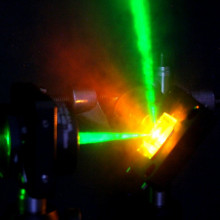
41:28 - Zapping cancer with lasers
Zapping cancer with lasers
with Dr Ceri Brenner, Rutherford Appleton Laboratory, Oxford
Could combining lasers with a mini version of the Large Hadron Collider provide 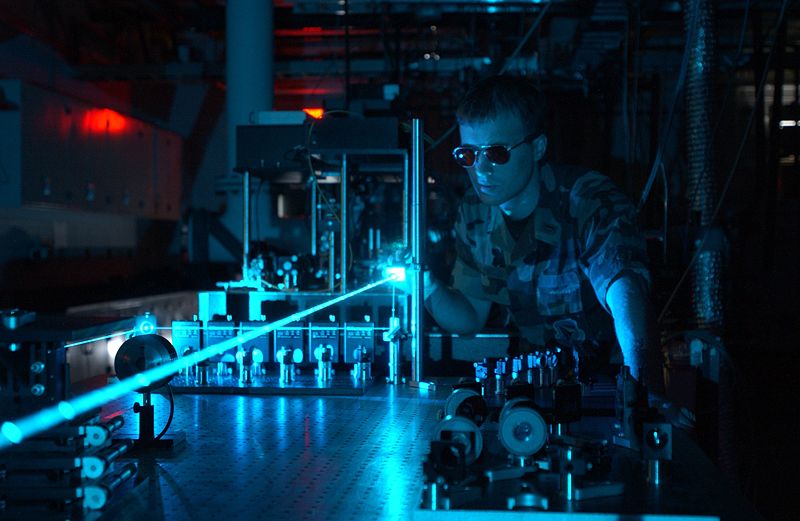 a treatment for cancer?
a treatment for cancer?
Recently, a young British boy called Ashya King, made headlines when his parents took him to Prague to receive treatment for a brain tumour using a technique called "proton beam therapy". This is available at only a small number of sites around the world because it's so specialist. It involves accelerating particles to very high energies and then firing them through the skin and into a tumour.
Calculations are done first to work out exactly how much energy to give the particles so that when they penetrate the body they come to a standstill slap-bang in the middle of the tumour where they release their energy and destroy the surrounding cancer cells. It also means that they do minimal damage to the surrounding healthy tissue.
But these machines are very large and very specialised, which is why so few of them exist. Instead, Rutherford Appleton Laboratory researcher Ceri Brenner is developing ways to generate these same particle beams using powerful lasers, which would enable the devices to become much more compact and widely available.
Hannah Critchlow went to meet her...
Ceri - There are two regions that plasma physicists such as myself are looking at related to cancer. So, one of them is using the laser to drive a pulse of x-rays that could be used for imaging. So, the imaging could be used to detect where those cancer cells are or the tumour is beneath the skin.
Secondly, that intense beam of laser light is actually so intense that it drives a microparticle accelerator, pushing forward a whole beam of particles of very, very high energies. There's a form of radiotherapy called Hadron therapy, using very energetic particles, bombarded them through the skin. As they crash through all the skin cells, where they slow down to absolutely zero, that's where they deposit loads of damaging energy.
Now, that sounds a bit scary, but if we manage to tailor those particle beams that they deposit all the damaging energy within the centre of that tumour, killing the cancer cells. But they don't deposit harmful energy to the surrounding healthy tissues. So, it seems like the dream cancer treatment really.
Hannah - Ceri has brought me down to a laser demo. So, it's basically a small scale version that could be used as future technology to zap away cancerous tissue.
Ceri - That laser is being focused down and the light intensity is so intense that it's heating the air into a plasma. Now the plasma is very, very hot. This could be up to a million degrees Celsius. Heating air very, very quickly gives off a soundwave. So, just as when lightning crashes down, we hear a thunder clap. We're hearing a miniature thunder clap right in front of us now where the plasma is being heated by the laser. Now, that laser plasma is the same process that we need to drive beams of particles through our Hadron therapy.
Hannah - Once you've generated this very fast particles of beam and it's zapping through my skin tissue, how do you inform it that it's going to stop at a particular distance to discharge the energy there and just target the cancerous tissue?
Ceri - So, that's an overlap in a radio biology and physics. So, as a physicist, I can understand. I can run simulations and codes and equations that will tell me that the particle with this starting energy will pass through this distance and then be stopped. The radio biologist then come along and say, "Well actually, you're not just bombarding through random material." The particles are travelling through cells and organic tissues. There are other things that you have to think about in your modelling of where that particle goes. But rightly said, that that's an extremely important part. This technology is correct modelling of how those particles travel through the body and where they deposit that energy in that dose. Because if we get that wrong, that's where the technology really fails, so that's crucial.
Hannah - At the moment, how sensitive and selective is this technology? So, if I had some cancerous tissue, how many cells would it wipe out that would be cancerous and how many neighbouring cells that might be healthy, but it also wipe out?
Ceri - The distance between the skin outside and the tumour that's with a certain depth beneath the skin, there'll be a slight fraction of that proton or ion beam particle dose delivered to the healthy tissue, but a very slight fraction. Actually, 80% or 90% of the energy is deposited within the tumour cells.
Hannah - How does this technique at the moment compare to existing cancer treatment?
Ceri - This again is an area of big debate amongst radio biologists and clinicians and doctors, and medical people. Particle beam therapy is actually ideally suited to dealing with tumours that are in very difficult to reach areas. So, if they're embedded within organs or perhaps they're on the edge of the eye for example or on the edge of the spinal cord or brain. Clinicians have also advised us that proton beam therapy is very good for children with cancers because if they're treated with proton beams, the chances of having what we call secondary tumours later in life from their treatment is low when you use proton beams. But if you use x-ray beams to treat cancers in young children, there's a chance that they develop secondary tumours from that very treatment that saved them in early childhood.
Hannah - So, this technique has been successfully used in humans to try and zap away their cancers?
Ceri - Yes and in fact, there are about 50 centres across the world and one in the UK that treats cancers of the eye. But traditional systems that accelerate particles are large and costly and they don't sit well within a hospital environment. I'd like to see these machines in every hospital around the world. But in order to do that, we need to make the technology smaller and better suited to a clinical or hospital environment. The laser plasma accelerators that I'm working on are better suited to that than traditional conventional accelerator machines. So, I'm predicting this to be, I'd say, a roughly 15 to 20-year plan and that's because we're still trying to figure out the physics of how to generate these beams repetitively and with the control you would need to use in a clinical environment. All these stages take time and a bit of patience, but have to get to see it within my career.
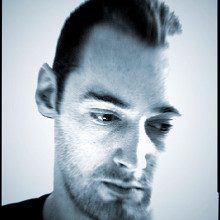
48:10 - The mental scars of cancer
The mental scars of cancer
with Dr Emma Cahill, Cambridge University
Over time, more and more people are undergoing treatments for cancer and many are  now being cured, largely thanks to advances in modern medicine. But how does the diagnosis affect a person's mental state, even if they are cured, and are we paying enough attention to the problem? Emma Cahill is a Cambridge neuroscientist and spoke with Ginny Smith about the issue.
now being cured, largely thanks to advances in modern medicine. But how does the diagnosis affect a person's mental state, even if they are cured, and are we paying enough attention to the problem? Emma Cahill is a Cambridge neuroscientist and spoke with Ginny Smith about the issue.
Ginny - Emma, are mental health issues, are they a serious problem for cancer survivors?
Emma - Well, it seems that they're going to be more of an issue in the future because as we heard earlier, more people are surviving from cancers. So, it's going to be important to actually consider this. In the past, until like the late 1990s, a chronic illness wasn't even one of the criteria that they included to diagnose people with posttraumatic stress disorder which originally was called shellshock and it was typically associated with war veterans.
But research groups that look into cancer like McMillan, their Report in 2013 found that of the 500,000 people living with cancer in the UK today, about 248,000 will develop mental health issues. So, these include depression and anxiety but also posttraumatic stress disorder.
Ginny - That's a huge number and is this the same kind of posttraumatic stress disorder that you see in war veterans and that kind of thing or is it a distinct kind of disease?
Emma - Well, that's hard to know because there's been a lot less research done on PTSD in cancer. But what we know is when it's being diagnosed, the same criteria are used. So, in the first instance, they look that the symptoms are actually persisting for more than a month since the traumatic event occurred and the symptoms they look at are a heightened sense anxiety. This can lead to poor concentration, trouble sleeping, and importantly, with posttraumatic stress disorder, something that's different from depression, is that they'll also have flashbacks or intrusive memories that are associated with the traumatic event.
Ginny - So, with a traumatic event such as being in a war, being shot at, you can kind of see that there'd be one trigger. But I guess with cancer, it's a long period. How would those flashbacks - would they be different?
Emma - Yeah, but it's hard to know. It could be coming as the forms of memories or nightmares and something you see quite often with posttraumatic stress disorder is an avoidance behaviour in the people suffering it. And that's why it's a particular concern in the case of cancer patients because they could be avoiding treatments or seeing doctors or seeing people that they associate with their cancer symptoms.
Ginny - Do you think it's something specific to cancer or do you think it's something about any kind of chronic disease that people may have recovered from?
Emma - For the moment, we don't know if it's going to be anything specifically associated to cancer. It's beneficial to think of it in this context because it's a new way of looking at posttraumatic stress disorder. The way it's conceptualised at the moment as a mental health issue is that it's a disorder of memory. And particularly, memories that are emotionally intrusive and they cause a state of anxiety in the everyday life. So, that could come from a traumatic event such as war, but also, from the pain associated with cancer treatments. One thing we can see across different types of cancers is that a common feature that leads to posttraumatic stress disorder in a certain percentage of patients is the duration of treatment. So, the longer treatment has gone on, further more likely they are to develop posttraumatic stress disorder.
Ginny - So, are there certain types of cancer that are more likely to give you posttraumatic stress disorder than other types?
Emma - That's not known at the moment. So, people are looking into this most of the time by focusing on a specific cancer. In certain cases, it's been suggested that childhood cancers might be more prone to posttraumatic stress disorder. But that's also because the survivors obviously are younger, so they're surviving for longer. So, you've got these confounding issues. But as I said, one common feature is the duration of treatment seems to be key.
Ginny - Now, you actually work on posttraumatic stress disorder itself and perhaps looking at treatments. Is there anything we can do to help people who are suffering with mental health problems after surviving cancer?
Emma - Definitely. Well, the first thing that is positive about being aware of PTSD in the context of cancer is that it's going to provide more research avenues, so people will be looking at this with a more open view.
At the moment, treatments include behavioural therapies, and meeting with therapists. What they regularly try to do is to make people remember or relive their traumatic experience in a safe context, and to lose the sort of emotional potency that they associate with this. That's also something that we look at in the lab as basic fundamental neuroscientists. We look at how fear memories can be reactivated and then we try and find what brain chemicals are involved in that, and see, can we block them with specific drugs to try and neutralise the emotional part of the memory. We don't want to ultimately wipe these memories, but just dampen them down so they don't have this emotional component that's the problem.
Ginny - So, I imagine that's probably the last thing a cancer survivor wants to do, is relive those memories. Why is that important if you are going to dampen down the emotions?
Emma - Well, it' important because we've known for a number of years that memories, once acquired by the brain are not just resistant and stored away like files in filing cabinet. Once a memory is recalled, it's actually opened up again and what we call 'de-stabilised'. So, in this stage, it can integrate new information and be updated. So, by retrieving your fearful memory, you de-stabilise it. in that instance, if you have interfering therapies, be there behavioural therapies or drugs, one of the ultimate goals for a lot of research right now is blocking the persistence of those damaging or fearful memories. So, you'll retrieve them, they become de-stabilised and at that point, you use a therapy which will prevent them from persisting.
Ginny - Quickly, you mentioned a drug that might be useful for this. How long is it going to be before we have one that we can actually use to help people or is it already there?
Emma - At the moment, there's no real drugs that can target the memory sides of PTSD. Most people are treated with antidepressants or anti-anxiety drugs. But research is really striving on to try and find particularly balance of the chemicals involved in the stress system such as adrenaline which not only has act on the body, but acts in the brain as noradrenalin. So, there's a lot of focus on blocking the receptors for noradrenalin in the brain and trying to understand how that might be able to be a future treatment maybe.
Ginny - Lots of promising ideas then. Thank you. That was Dr. Emma Cahil from Cambridge University.

53:45 - Why did my facial hair grow back white?
Why did my facial hair grow back white?
Sara - To get to the root of the issue, I spoke with dermatologist, Jane Sterling from Cambridge to find out how hair gets its colour in the first place.
Jane - The colour that comes into any hair comes right from the root and there are some cells there, those are the tiny little bits of the body that actually make the hair and they inject into the hair some hair colour, the pigment called melanin. So, that might be a lot in black hair, a bit less in brown hair or very much less in blonde hair. And red hair has a slightly different type of melanin. So, when we lose our hair colour, what's happening to the cells in the root of the hair is that they start to produce less and less of the pigment until eventually, they don't produce any at all.
Sara - Now, we often see grey hair speckled in among darker strands, but is it possible for people to grow grey in a distinct patch of hair while the rest keeps its youthful shade?
Jane - That sounds like a condition called vitiligo in which the immune system for some reason attacks a small area of your skin and that makes both the skin and the hair growing within it go very pale compared to the rest of the skin. You can see it on the body, in the scalp, or in the beard area and obviously, a hairy area, you'd notice the hair going white more than the skin.
Sara - Vitiligo isn't dangerous and affects about 1 in 100 people. But remember, a lack of melanin means less protection against UV rays. So, make sure to put sunscreen on the white skin when you shave to avoid any nasty burns.










Comments
Add a comment